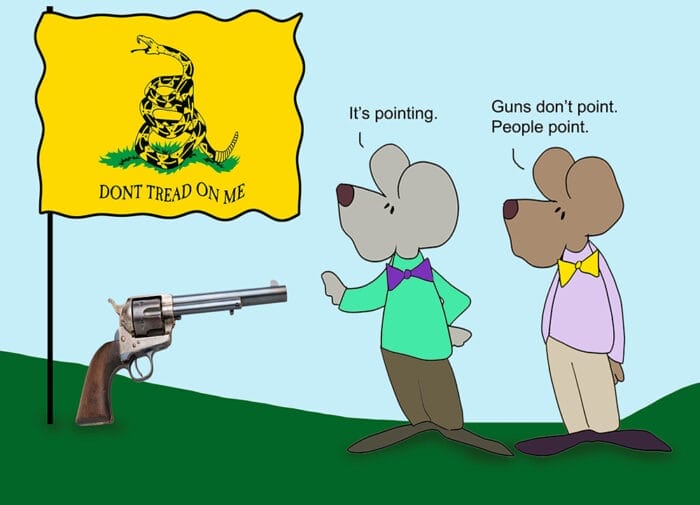The United States has a problem with guns. We are the world leader when it comes to those privately owned guns, with 120 guns per 100 people nationwide. European countries have far less. For instance, England had five guns per 100 people.
There are more deaths per year in the United States by firearms than car accidents. The CDC reports the number of deaths last year by gun was 39,740. Car accidents accounted for 37,991.
I could talk at great length about the culture around this situation, the conspiracy theories, the yellow “Don’t Tread On Me” flags, Charlton Heston’s “cold dead hands.”
But I won’t.
It appears the only way to stop school shootings in our country is to have a global pandemic sweep across the nation, killing nearly 400,000 people in the length of a school year. Now that’s a trade-off, isn’t it?
Secretly, I always seem to put part of the blame on Samuel Colt. I know that is unfounded, as someone else would have come along and invented a revolver sooner or later. But he is the chap who put “ease” into firing a gun rapidly.
Today, January 4, 1847, marks the day that Samuel Colt sold his first revolver pistol to the United States government.
His early beginnings were colorful, to say the very least.
He was born in Hartford, Connecticut. His parents were farmers to start out with. But then the father, Christopher Colt, started a business, a textile plant.
Probably his earliest shaping on guns started with his maternal grandfather, Major John Caldwell. Major John had been an officer of the Continental Army. And he gave his little grandson Sammy one or his flintlock pistols. I imagine this had a lot to do with his obsession with guns. Personally, I don’t think I saw an actual gun until I moved to Preble County when I was 25 years old.
Anyway, Samuel Colt lost a lot of people early on. His mother, Sarah Caldwell, died from tuberculosis when he was six years old. Colt had three sisters. The first died during their childhood, one way or another. An older sister, Margaret, died of tuberculosis at age 19. Finally, another sister, Sarah Ann, committed suicide.
One of his brothers, John C. Colt, was convicted of murder in 1841. He committed suicide on the day he was to be executed.
Back to Samuel. His dear old dad sold him off. At age 11, Colt was indentured to a farmer in Glastonbury, CT, where he did chores and attended school. It was here that he started getting his bright ideas. He was introduced to the Compendium of Knowledge, a scientific encyclopedia. He loved this book. There were articles about all sorts of scientists, discoveries, and inventions. There were experiments with gunpowder, and on. Sparks in his little brain.
By the age of 15, he was back homeward, and Colt began working in his father’s textile plant. Some of the factory workers had knowledge in a wide variety of areas, and Colt learned from this. In addition, with that good scientific encyclopedia, he referenced an article and built a homemade galvanic cell. A little bomb. He advertised this as a Fourth of July event and said he would explode a raft using underwater explosives. He didn’t quite get the raft, but apparently, the explosion was pretty impressive. His father sent him to boarding school, where he amused his friends with pyrotechnics. One accident caused a massive fire that ended his schooling there.
Eventually, he went back to work for his father, and it was there he learned about nitrous oxide (laughing gas) from the factory chemist of his father’s textile plant. So he mapped out a plan to make money with this nifty gas. He made up a portable laboratory and took it on tour. He gave “laughing gas” demonstrations across the United States and Canada, calling himself “the Celebrated Dr. Coult of New-York, London and Calcutta”.
He started simply enough, giving his lectures on street corners. But he gained momentum and soon found himself in lecture halls and museums. As ticket sales decreased, Colt realized he could make bigger money telling stories of salvation and redemption, which the public seemed to crave. This goes on and on, with Colt gaining profits on his escapades.
So with the money he had saved, he switched gears to the role of inventor, focusing on the development of his revolver. And essentially, from there, the steps followed until he had his first design and patent in 1835.
A little history on the beginnings of guns in America. I wonder how many people have been killed by Colt revolvers. Any way you look at this, we have a problem.
=========
“Speaking personally, you can have my gun, but you’ll take my book when you pry my cold, dead fingers off of the binding.”
― Stephen King
=========
“The fascination of shooting as a sport depends almost wholly on whether you are at the right or wrong end of the gun.”
― P.G. Wodehouse, The Adventures of Sally
==========
“You don’t spread democracy with a barrel of a gun.”
― Helen Thomas
==========
Thanks to Colt, it keeps revolving.
